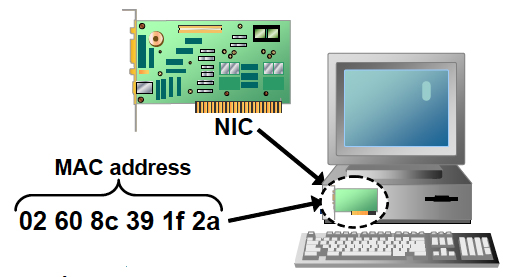While Apple has created many fine things, they were yet to be created themselves when Xerox PARC scientists created Media Access Control addresses. These MAC addresses are 48 bits or 6 bytes long, so they are also known as MAC-48 or EUI-48. EUI stands for Extended Unique Identifier. It is written in hexadecimal characters as shown below:
MAC addresses act as the physical addresses for local communications. They show up in most IEEE 802 networks including: 802.3 (as well as Ethernet II), 802.5, 802.11 (Wi-Fi), 802.15 (Bluetooth), and the ITU-T G.hn standards.
The IEEE now manages MAC addresses. Their current projection is that the amount of addresses available with 48 bits (over 281 Trillion) will last until 2100. They have already planned to extend the MAC address space to 64 bits and will call it EUI-64.
There are three types of MAC addresses: Unicast, Multicast, and Broadcast. The way to identify which address type you are viewing is simply look at the first byte. A unicast address’s first byte will be even, like 02, 04, 06, etc. The first byte of a multicast address is odd, such as 01, 03, 05, etc. The broadcast address uses all 1s binary or all FF hex. That way, any receiving interface can tell what kind of destination address it is reading after just reading one byte.
To work correctly, each network interface has to have an address that is unique in its local segment of media. That address is the unicast address. To help that process, Ethernet card vendors support that uniqueness by registering with the IEEE. They get one or more Organizationally Unique Identifiers. TCP/IP literature refers to this OUI as the vendor address component of the MAC address.
The first three bytes (pairs of hexadecimal characters) of any unicast address contain that vendor address component of the MAC address. The remaining three bytes carry the serial number of that vendor’s interface card.
| OUI | Vendor |
| 00-00-36 | ATARI Corporation |
| F0-4D-A2 | Dell, Inc. |
| E8-06-88 | Apple, Inc. |
| E8-E0-B7 | Toshiba |
| 00-02-A5 | Hewlett-Packard Company |
| B4-A4-E3 | Cisco Systems |
| 2C-21-72 | Juniper Networks |
| 00-A0-C8 | ADTRAN, Inc. |
| 40-B2-C8 | Nortel Networks |
| 00-AA-02 | INTEL Corporation |
Many vendors have chosen to register multiple different OUIs for lots of different reasons. They may want to use each for a specific product or simply because they ran out of serial numbers on a previous OUI. The full list is available at http://standards.ieee.org/develop/regauth/oui/oui.txt.
Although many vendors are careful to abide by the standards, others are not as careful. A vendor's careless use of a code registered to another vendor may result in two or more NICs having the same Ethernet address. If cards with duplicate MAC addresses are installed on the same side of a router, results will be unpredictable.
Related courses to develop these skills


 Worldwide Locations
Worldwide Locations

